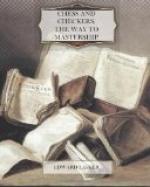(4) ... Qxd5 (5) Pxd4 Kt-c6 (6) Kt-f3 B-g4 (7) Kt-c3 Q-h5
and Black has, no doubt, the initiative.
If White, instead of playing (2) P-d4 as assumed in the above examples, advances his f-Pawn against Black’s center, Black has ample time to make all preparations necessary to maintain his center-Pawn, for White does not threaten Pxe5 as long as he is not protected against Q-h4+, followed by Qxe4. Black’s best move is apparently B-c5, so that he may be able to reply P-d6 to (3) Kt-f3 without blocking the way of the Bishop. On c5 Black’s Bishop is very disagreeable for White as he prevents his castling. The natural development of this opening would be about this:
(2) P-f4 B-c5 (3) Kt-f3 P-d6 (4) B-c4 Kt-f6
Although this move blocks the diagonal for Black’s Queen, making impossible a check on h4, it does not enable White to win a Pawn on e5, because (5) Pxe5, Pxe5; (6) Ktxe5 would be answered by Q-d4.
(5) P-d3 Kt-c6 (6) Kt-c3 B-g4
Black has one more piece developed than White on account of the Pawn move P-f4 which is a wasted move from the point of view of development, especially as White cannot very well castle on the King’s side and make use of the open f-file for his Rooks.
The two principles mentioned—namely the development of the pieces without unnecessary Pawn moves or other loss of time and the maintenance of a Pawn in the center—are a perfectly sufficient guidance in all King’s Pawn openings, as no particular difficulty exists for any piece to be developed to a favorable square. Even if Black tries to avoid the well-known openings which result from the reply (1) ..., P-e5 by playing (1) ..., P-e6 for instance, or (1) ..., P-c5;, or, in fact, any other of the twenty possible first moves, White will find the right way to mobilize his men if he strictly adheres to those two principles and resists the temptation to institute an early attack. A few examples will show how simple the application of the principle is.
I. (1) P-e4 P-d5
This attacks White’s Pawn and White has to decide whether to protect, advance or exchange him. The advance P-e5 and the protection P-f3 are out of question because these moves are Pawn moves which do not contribute to the development and are, therefore, to be classed as mere loss of time. The protection (2) P-d3 is not sufficient either as Black, after exchanging on e4, would hamper White’s development by exchanging Queens so that White would lose the right of castling. The protection (2) Kt-c3 cannot be recommended as Black could deprive White of his center-Pawn and obtain one for himself by Pxe4, (3) Ktxe4; P-e5. For all these reasons White cannot do better than exchanges on d5.




